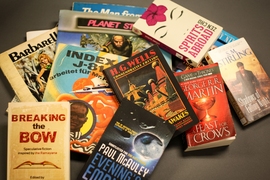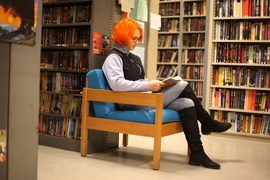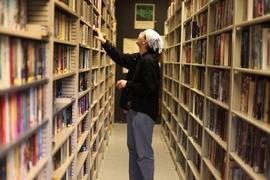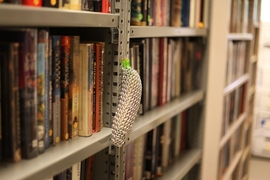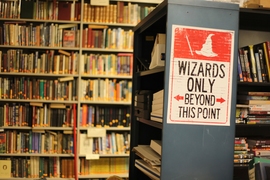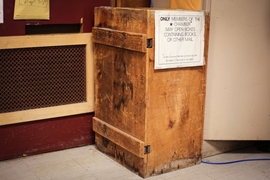It is a Tuesday night, and on the quiet fourth floor of MIT’s otherwise bustling Stratton Student Center (W20), the MIT Science Fiction Society (MITSFS) is holding open hours. Inside room W20-473, colorful books line the walls from floor to ceiling.
“We aim to have a library full of science fiction and fantasy and horror, and tangentially related genres, that we can make accessible to MIT, the community, and anybody else who’s interested,” says Laura McKnight, the Society’s “vice” — a role she describes as “approximately vice president” — for the current academic year.
Just inside the door, a small plywood box is stacked on its end. This, McKnight says, is the Society’s original library. When freshman Rudolf “Rudy” Preisendorfer founded MITSFS in 1949, members would pass their books from dorm room to dorm room in this box. Things have changed a bit in the last 65 years.
“Our total book count is, last I heard, 62,270,” McKnight says. “At one point, our goal was to collect all the science fiction that had ever been published. But with the rise of self-published science fiction, that’s not even sort of possible anymore.”
Still, MITSFS (pronounced “MITS-fiss”) maintains what is believed to be the world’s largest open-shelf collection of science fiction. The Society strives to acquire every new science fiction publication for its collection, sometimes obtaining proofs before a book is officially published.
The results are staggering: In addition to the two rooms of stacks in W20, MITSFS maintains a warehouse facility for extra copies. “We do all sorts of shenanigans to try and fit as many books as possible in,” says McKnight, adding that ladders are required to reach the top shelves of paperbacks.
The age of many of the library’s materials hints at how far MITSFS has come. McKnight points out “Weird Tales” — an anthology of stories from a science fiction magazine of the same name that was published from 1923 to 1954 — beside several other periodicals that were hand-bound by members over the years. Early science fiction was primarily published in magazines, McKnight says, and the Society’s collection is full of stories that “you can’t really find many other places.”
The culture of the Society also reflects the past. “Since MITSFS is so old, we have a lot of basically 50-year-old in-jokes that nobody remembers the origin of,” McKnight says. As evidence, she points out the library’s curious collection of bananas, which are everywhere — strung from the ceiling, tucked into shelves, and sitting on the limited desk space by the doorway. The bananas are plush, rubber, or plastic; one is dressed in chainmail, while another has a shark erupting from its peel.
McKnight says nobody knows how the fruit obsession began, but that members may check out certain bananas to take home with them. “Be warned that we have a digital electronic checkout system, and if you return the banana late, it will fine you,” McKnight says.
Most MITSFS members come to check out not the bananas, but the books — up to eight at a time, for as long as three weeks. Membership is not restricted to MIT students; McKnight notes that many alumni retain membership, and members don’t even have to be affiliated with the Institute at all — although MIT students do pay a discounted membership rate.
McKnight estimates that there are “some number of hundreds” of members this year. And Jesse Ashcraft-Johnson, a “keyholder” in the Society — he has a key to the stacks, and can hold the library open — thinks that if there were a single sheet of paper representing each member, they “would fit into a reasonable binder.” These members carry on a labor of love 65 years in the making.
After wandering through the stacks, the “original library” by the doorway seems quaint. The box has now become a time capsule, McKnight says. There’s only one problem, she says: “Nobody knows when it’s supposed to be opened.”
For now, it remains sealed by the stacks, a testament to how far MITSFS has come.
